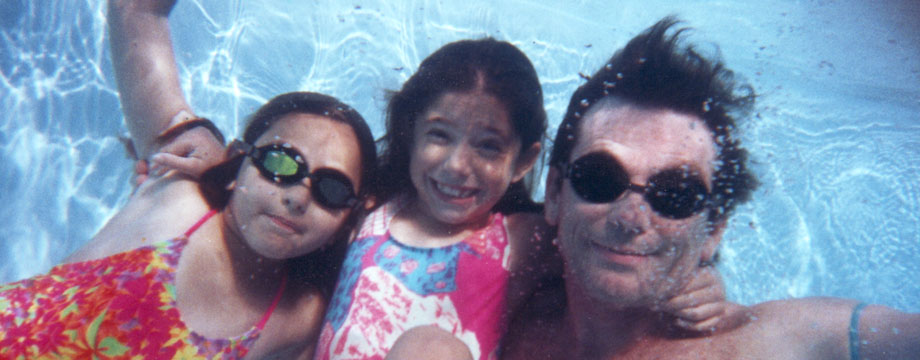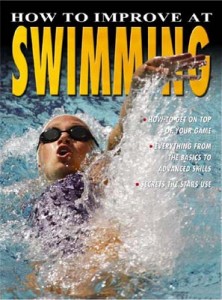Learn to Swim in a Weekend
Sharon Davies
Alfred A. Knopf, 1992
Reviewed Nov. 22, 2017
This book may have been written with a noble cause, but I think it is quite unrealistic to propose that a person can learn to swim in a weekend. For a non-swimmer, so much is mental, and learning to stay afloat, while relaxed, would be a more realistic goal. If you are a non-swimmer and want to give it a try, I suggest you find a friend who can swim, who can help you work through the book. I have several concerns:
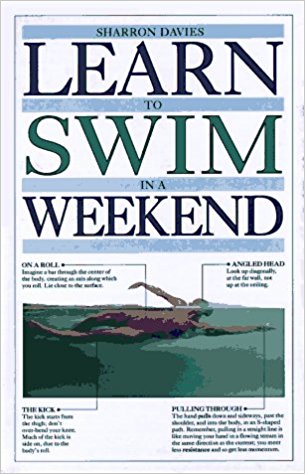
There are several variations of this cover.
Davies proposes that on day 1, 3 ½ hours, and 4 hours on day 2 should be done in the pool. This is an intense schedule. To get better results I recommend doing 1-2 hours for 4-5 days, over a week or two.
There is no real attempt to teach a proper floating technique in chapter 2—only face down floating and using a kick-board for buoyancy!
Chapter 3 has a section on sculling, but no treading water or “survival swimming” techniques are stressed.
Chapters 4 and 5 introduce the breast and back strokes. I disagree with this plan, since breast stroke, though relaxing and powerful when done properly, is one of the most difficult strokes regarding timing, breathing, and a complex kick. I am a fan of the dog paddle and the front crawl as the first actual strokes for beginners.
Since this book was published in 1992 there have been some changes in stroke mechanics, but there are a few tips that were not part of recommended technique, even back then:
- For the arm recovery for backstroke, she advises that the little finger should leave the water first. This is awkward and wrong—the thumb should exit first, and the hand is turned during recovery so that the little finger is first on the hand ENTRY.
- Also, in the front crawl, a proper head position is said to be when the waterline is at the mid-forehead area. Wrong since the 70s–this strains the neck, increases drag, and tends to cause the hips to sink, creating even more drag. Proper technique is to look at the bottom, slightly ahead, with the waterline near mid-scalp.
Much of this book might be better thought of as a general overview of advanced skills, such as butterfly, alternate breathing in the crawl, and racing turns. Before you tackle these methods, you must master floating and swimming the crawl comfortably for several hundred yards, and that will take many hours of careful practice.
I cannot recommend it as a useful guide for learning basic swimming and water survival skills.
The Complete Beginner’s Guide to Swimming
Shaney Frey (1975, Doubleday & Company, Inc.)
Reviewed September, 2014
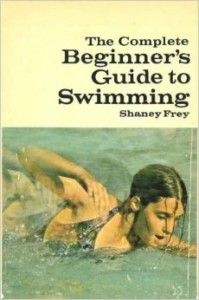 This book has a logical progression of drills, skills, and tips to help students learn to swim and continue to improve. The major strokes are covered, including Drownproofing (briefly mentioned as floating and bobbing). Tips for open water swimming are offered, but may be confusing due to strange diagrams (see Wrong or just Weird). There are plenty of clear underwater photographs to make the concepts easier to understand. Very clear line drawings are included, but unfortunately, like so many of these books, they are only from one point of view. For clear illustrations of swimming strokes that are 3-dimensional, a simple side view is not adequate!
This book has a logical progression of drills, skills, and tips to help students learn to swim and continue to improve. The major strokes are covered, including Drownproofing (briefly mentioned as floating and bobbing). Tips for open water swimming are offered, but may be confusing due to strange diagrams (see Wrong or just Weird). There are plenty of clear underwater photographs to make the concepts easier to understand. Very clear line drawings are included, but unfortunately, like so many of these books, they are only from one point of view. For clear illustrations of swimming strokes that are 3-dimensional, a simple side view is not adequate!
The most problematic section covers rescue techniques that are best left to expert swimmers in lifeguard training. It is very dangerous to imply that a water rescue (rescuer swims to aid the victim) can be successful with out advanced training and much practice under the guidance of an expert instructor. Water rescues without training often turn tragic, resulting in 2 people drowning.
Also, in the section on competitive swimming, Ms. Frey has one of the strangest crawl stroke diagrams I have ever seen (link to Wrong or just Weird)! The swimmer appears to have 2 left hands, and is advised to trap air between the fingers!
My philosophy on these books is “it’s worth a look,” as you might find some useful tips, etc. that can be added to your “toolkit” for teaching swimming, but it’s not recommended as a sole source.
Drownproofing Techniques
Dr. Reagh C. Wetmore (1981, Boston University)
Reviewed September, 2014
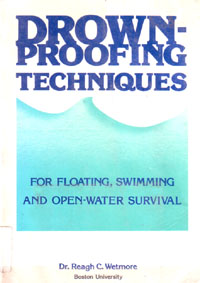 The basic techniques of “Drownproofing” were developed by Georgia Tech swim coach Fred Lanoue, and was first taught in 1940. It is estimated that he taught 20,000 students this lifesaving technique. Once they had mastered the Drownproofing technique, students learned how to stay afloat with their wrists and ankles bound, swim 50 yards (46 m) underwater, and retrieve diving rings from the bottom of the pool using their teeth. Drownproofing was adapted by the U.S. Navy as part of survival training.
The basic techniques of “Drownproofing” were developed by Georgia Tech swim coach Fred Lanoue, and was first taught in 1940. It is estimated that he taught 20,000 students this lifesaving technique. Once they had mastered the Drownproofing technique, students learned how to stay afloat with their wrists and ankles bound, swim 50 yards (46 m) underwater, and retrieve diving rings from the bottom of the pool using their teeth. Drownproofing was adapted by the U.S. Navy as part of survival training.
The key to drownproofing is relaxation and mental control to survive relatively long periods of time in the water. Most boating accidents are too far from shore to make “swimming for it” a smart strategy. Drownproofing teaches swimmers and non-swimmers to keep their head and maintain slow progress to safety by a combination of floating, bobbing, and using basic arm and leg movement. Note that these techniques have also been adapted and re-branded as “Survival Floating” and the “Survival Stroke” by the Red Cross and other organizations.
Georgia Tech dropped Coach Lanoue’s course in 1987, due to downsizing of the Physical Education program, but Dr. Wetmore was a strong advocate and teacher of Drownproofing at Boston University, until his retirement in 2005. This book uses a combination of underwater photography and clear text to illustrate the training and techniques for mastering Drownproofing.
I highly recommend this book, and believe it should be required reading for swim instructors and others who want to be safe in the water, using the most basic techniques that are easy to learn.
Teach Yourself to Swim…Despite Your Fear of Water
Mick Arellano (1978, Hawthorn Books, Inc.)
Reviewed September, 2014
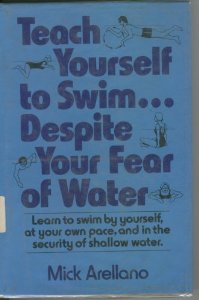 Mr. Arellano has made a noble attempt to help people overcome their fear of water and self-teach themselves to swim. Though it was written in 1978, there are several problems that are not due to any “dated” information. Here is a brief list of shortcomings:
Mr. Arellano has made a noble attempt to help people overcome their fear of water and self-teach themselves to swim. Though it was written in 1978, there are several problems that are not due to any “dated” information. Here is a brief list of shortcomings:
- Suggestions of where to swim include lakes and outdoor pools. But for some reason, he advises the learner to “Stay away from indoor pools. They are usually dark and unpleasant.” This is nonsense! I have been in many indoor pools, some built in the 1930s, but none fit his description. An indoor pool can be ideal, because it offers sun protection and warm water, year round (vs. summer only).
- There is too much text. He tries to be reassuring, but it really gets to be rather maudlin. Yes, we know you’re afraid of the water, but let’s get on with it!
- The instructions focus on spending a great deal of time in very shallow water—less than waist deep. Crawling while touching the bottom has limited value in making progress.
- The student is often encouraged to hold their breath. There is no mention of practicing rhythmic breathing by bobbing and blowing bubbles. This is an essential skill for all swimming and water safety.
- For the crawl, he specifies the “six-beat” method where each kick and arm movement are precisely coordinated. This is very old-school and creates a huge mental block for students. They cannot possibly break motions down this way. They will over-think it instead of just going “with the flow” and working on improving kicks and strokes while feeling how they move through the water.
- Finally, there is no mention of survival strokes or “drownproofing” techniques from the 1960s that should be learned by anyone who wants to be safe around deep water.
Not Recommended! This book should be pulled from circulation—it’s confusing, tedious, and generally useless for the target audience.
Teaching Swimming Fundamentals
YMCA publication (1999, Human Kinetics Publishers, Inc.)
Reviewed June, 2014
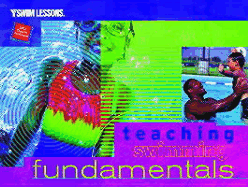 If you teach swimming at the YMCA, this is your “bible”. If you are interested in educational psychology, it has a great deal of information on child development, learning theory, and offers examples that apply to teaching in general. Thirty people are acknowledged as contributors, and that may be the cause of it’s main shortcoming: the scope is too broad to help the average person teach swimming. There is just too much non-swimming material in educational psychology and areas of behavior that are more applicable to an employee handbook (e.g. “YMCA staff or volunteers will not verbally or emotionally abuse or punish children.”).
If you teach swimming at the YMCA, this is your “bible”. If you are interested in educational psychology, it has a great deal of information on child development, learning theory, and offers examples that apply to teaching in general. Thirty people are acknowledged as contributors, and that may be the cause of it’s main shortcoming: the scope is too broad to help the average person teach swimming. There is just too much non-swimming material in educational psychology and areas of behavior that are more applicable to an employee handbook (e.g. “YMCA staff or volunteers will not verbally or emotionally abuse or punish children.”).
After 6 chapters of non-swimming material, in Chapter 7, (page 102 of 189) they get around to “Teaching Strokes”. This chapter is only 32 pages. Basic stroke sequence photos and drawings are included–better than the glossy “incorrect” ones found in other books reviewed on 1000 Swimmers. The photos are mostly above water shots, but are still useful.
Unfortunately, they spend 7 pages trying to explain physics principles–a noble idea, but it just seems tedious and unnecessary to get on with helping beginners and non-swimmers. Their attempt (p.115) at explaining “Bernoulli’s Theorem” (? most scientists call it the Bernoulli Principle) is off the mark for 2 reasons (both featured in the infamous “Wrong or just Weird?” section):
1. The “airfoil/propellor/lift” principle for swimming has been largely discounted by advanced research (since this was published in 1999 so we should cut them some slack for not being up to speed). Our hands and forearms (a big source of thrust OR drag) simply are not shaped like airfoils. Sculling is still a useful technique, but the diagram of a hand is confusing, at best.
2. The kickboard drill, as described to illustrate this is incomprehensible relative to Bernoulli.
Also lacking are answers to basic questions that arise when teaching beginners:
When and how should goggles be used in the pool?
What is the best water temperature for swim lessons?
The pages devoted to competition techniques (e.g. flip turns) are pretty far off topic. That would best be delivered in a book for good swimmers wanting to get on a team.
Also, they show children wearing IFDs (Instructional Floatation Devices), one of which is troubling. It is called a float belt, and is a small foam flotation pack, similar to an “egg” that straps around the child’s chest. These floats tend to cause the child to float face down, and make it difficult to get upright, as they are placed far from the body’s natural center of buoyancy. The book (p. 72) specifically advises the reader that, “When used too long, the float belt becomes an emotional crutch and can impede the development of proper body position.” I couldn’t agree more!
For the instructor, it has many games and checklists that would be useful when planning swimming lessons, whether they are YMCA lessons or not. This book is recommended as supplemental for an instructor or adult who wants to get deeper knowledge of learning theory and child psychology.
Safety Around Water
by Marylee Knowlton
(Crabtree Publishing, 2009)
Reviewed May, 2014
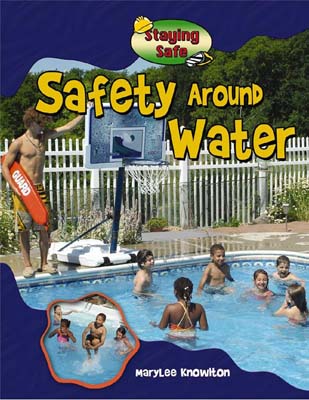 This 30 page book doesn’t offer any skills instruction–just general safety around water, but I didn’t want to create a whole new category. The target audience is small children (my guess: grades 2-4), and the material is presented as scenarios where the child is offered 3 choices (A, B, C) as answers to a “water safety problem.” Then, each answer is explained, and answer C is always the best one! Here’s an example that deals with running on deck:
This 30 page book doesn’t offer any skills instruction–just general safety around water, but I didn’t want to create a whole new category. The target audience is small children (my guess: grades 2-4), and the material is presented as scenarios where the child is offered 3 choices (A, B, C) as answers to a “water safety problem.” Then, each answer is explained, and answer C is always the best one! Here’s an example that deals with running on deck:
You and your brother are playing in the pool. You see some friends at the other end of the pool. You can’t wait to get over there to play with them. What should you do?
A) Get your brother to jump out of the water and run with you to the other end of the pool to play.
B) Run to the other end of the pool by yourself to play with your friends.
C) Walk carefully or swim to the end of the pool to join your friends.
A common answer to many of the questions (and always “C”) is to summon a parent or lifeguard before doing anything. I think the best use for this book is for an adult to read with the child and discuss each scenario. Since peer pressure is a major factor in children’s behavior, the adult should try to work this into the discussion. In the heat of play, we can’t expect these kids to think so clearly or rationally. And adults should always watch their children at the pool. The lifeguards are more of a backup system, and most pools require youngsters to be accompanied by an adult.
This book is recommended as a useful tool for teaching kids water safety.
Swimming
by Joanne Randolph
(Children’s Press, Div. Scholastic, Inc., 2001)
Reviewed May, 2014
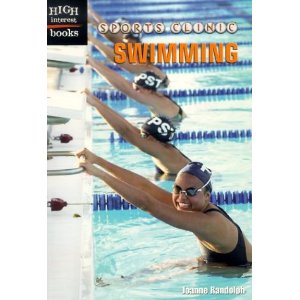 In the Introduction, the author writes,
In the Introduction, the author writes,
“This book helps you master the strokes. It also teaches you other tricks. You’ll learn how to explode off the blocks. You’ll learn how to make great flip turns. This book teaches you the skills you need to be a winning swimmer.”
Sorry, but with 45 pages of content, minus 6 pages of full-page photos that really teach nothing, there is very little “meat” to back up the introduction. But what’s really odd is the format versus the level of the text. It seems written for middle school readers or above, but it’s a small, thin book typical of lower elementary grade level books.
Because I’m not an expert at really judging reading levels, I ran a full page of text (p. 38 “Nutrition”) through several reading analysis programs which can be found on the Net. My gut feeling was correct–levels ranged from 5th through 9th grade! I can’t imagine any self-respecting 7th grader being caught carrying this “kiddie book.”
As in most of these tiny books, there is an attempt to show or describe proper technique, but there is no depth, and a lack of good sequential images. The only good thing I can say is, this book doesn’t have any “bad” images (as shown in the “Wrong or just Weird” page). To put it bluntly, this book isn’t really going to make anybody a winner! Also, it’s annoying to keep reading references to “tricks“, as mentioned in the Introduction. There are no tricks to winning–just hard work, practice, and guidance from a knowledgeble coach/teacher/mentor. This book appears to be “sincere” (vs. “slapped together”) but is incomplete, at best.
Conclusion: It’s “o.k. for a look,” but not recommended as a step to becoming a winning swimmer.
How to Improve at Swimming
by Paul Mason
(Crabtree Publishing Company, 2008)
Reviewed May, 2014
Here is another book that is similar to The Young Swimmer (below). In 43 pages of content, the author seems to be addressing the 10 yrs. and older reader, and he covers a variety of topics, but beyond the colorful pictures, there is very little information that is helpful for either beginners or more advanced swimmers that are truly looking to improve fitness or technique. The cover promises to deliver “Secrets the Stars Use”, but sorry, it’s nowhere to be found. We all know that the stars train hard and have physical gifts (especially above average height) that are not really “secrets.”
Subjects include pools, equipment, warm-ups, nutrition, learning to dive (from the pool deck), the 4 racing strokes, starts and turns, training regimen, race strategy, water polo, and lifesaving.
The colorful illustrations include the goofy “dry land” photos with water added in the final graphics layout. Many photos don’t match the captions, and others are misleading and incorrect illustrations. There are samples in the “Wrong or just Weird” section.
This book is not recommended for serious efforts to improve, and could be detrimental due to wealth of inaccurate or incomplete material.
The Young Swimmer
by Jeff Rouse
(DK Publishing, 1997) Reviewed April, 2014
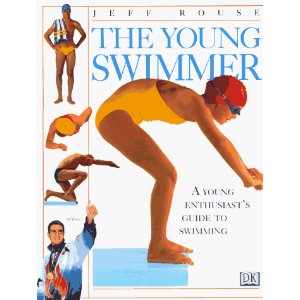 The author, Jeff Rouse, was a champion backstroker in the mid-1990s. Rick Cross is listed as a consultant. At only 30 pages of content, this book is targeted at younger readers (est. grades 4+).
The author, Jeff Rouse, was a champion backstroker in the mid-1990s. Rick Cross is listed as a consultant. At only 30 pages of content, this book is targeted at younger readers (est. grades 4+).
Pros:
1. It’s graphics and clean design layout should appeal to young readers. It wasn’t “slapped together.”
2. The four major strokes and competitive techniques are covered, along with some history notes and photos.
3. There are some useful sequences and underwater photos to illustrate various techniques.
Cons:
1. In attempting to cover everything from equipment, pools, history, learning to float and glide, to advanced/competition swimming in 30 pages results in very little depth on any of these topics.
2. There are some totally incorrect images in the “how-to” sequences that are dry-land photos with the water added by a graphic artist. (See the Wrong or Just Weird? page).
3. Some of the content indicates lack of attention to detail–the images and text don’t match up or really seem questionable as models for any good swimming instruction set. In fact, this book has inspired me to start a new page that highlights the “Wrong or Just Weird?” without cluttering up these reviews. Link to Wrong or Just Weird?
Sorry, this book is more style than substance and I don’t recommend it as a source of serious swimming instruction.
Swimming: Steps to Success, 2nd Ed.
by David G. Thomas
(Human Kinetics Pub., 1996) Reviewed Jan. 2014
The author is very methodical in laying out a structured program that is intended to help non-swimmers become competent in the water. Here are some points worth noting:
Pros:
1. The book has many clear line drawings.
2. Each activity has “Success Goals & Checklists”.
3. It is a set of “lesson plans” that both students and teachers can use*.
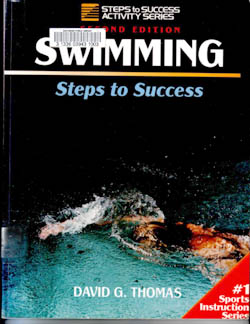 Cons:
Cons:
1. There is an old axiom in sports that cautions athletes against “overthinking”. For example, trying to break down the motion of throwing a ball into 4-5 steps is confusing and counterproductive (vs. practicing and “remembering” the feeling of good throws). This book overthinks swimming. On page 96, there is a long paragraph on counting kicks (6-count) and synchronizing it with the arms in the crawl stroke. Here is a sample:
“On the count of five the breathing-side arm pulls through, and you inhale (see Fig.9.2f ) On the count of six the arm recovers to the level of your head, ready to enter the water, elbow high.”
Just My Opinion: I believe this makes it much harder to develop a feel for the water. Trying to do this, let alone teach it, would drive me crazy, even after swimming for over 50 years!
2. “Equipment overload” is everywhere: paddles, fins, mask, snorkel, leg floats, “deep-leg float” (looks like a plastic jug tied to a cord), body floats, and more. More opinion: I think strapping on foam float vests or a milk jug on cord is not constructive for developing confidence and a feel for the water.
3. The material is presented in a sequence that may intimidate some because so many exercises and drills that come before the freestyle/crawl as an integrated stroke. The crawl is in Ch.9 of 12, after the backstroke and many drills with mask, snorkel, floats, and “partial” stroke and kick exercises. More opinion: The mask and snorkel should be a last resort, not a routine method for teaching people to pull with their arms while their face is in the water. The less floatation aids, the better!
*The cons outweigh the pros, and I cannot recommend this book. There is a 3rd Ed. now (2014), but sample pages on Amazon indicate not much has changed from the 2nd Edition.
Teaching Your Child to Swim
by Eva Bory
(Tradewinds, 1971) Reviewed Oct. 2013
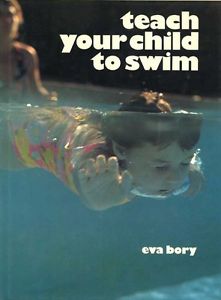 Synopsis: This book is rather dated, since stroke mechanics and technique have changed over the past 40 years. The focus is on helping parents teach their youngsters basic swimming–stroke perfection is not the main goal. There is some useful information for children of various ages and skill levels–from beginners to those ready to try competitive swimming, however I cannot recommend it as a teaching aid because of some odd advice and practices. These sections caught my eye:
Synopsis: This book is rather dated, since stroke mechanics and technique have changed over the past 40 years. The focus is on helping parents teach their youngsters basic swimming–stroke perfection is not the main goal. There is some useful information for children of various ages and skill levels–from beginners to those ready to try competitive swimming, however I cannot recommend it as a teaching aid because of some odd advice and practices. These sections caught my eye:
Regarding goggles on children in a pool, Bory says:
“Goggles are very dangerous in swimming pools. They are fun on the beach. When you get a pair of goggles for your child, be on the lookout for they will want to duck under the water all the time.”
This seems to be an over-reaction, since most kids wear goggles nowadays, mainly to keep from burning their eyes with pool water chlorine, etc.
Also, Bory suggests using a “magic egg” float on little ones. This device is an egg shaped float that straps on a child’s back, using a strap around their midsection. I believe this is counterproductive and possibly dangerous–the child will tend to float face down.
Finally, Bory discusses her method of teaching a child to be comfortable under water, blowing bubbles, and coming up for a breath. Unfortunately, she seems rather tough on the kid:
“Hold them by the shoulders, push them under the water, let them blow all the air out, then lift their heads out, let them take a big breath and push them under the water again. If they tend to touch their eyes with their hands or shake their heads, hold their hands firmly so they can’t.”
I recommend this book for historical and entertainment purposes only. It should not be used for teaching!
The Complete Idiot’s Guide to Swimming
by Mike Bottom and Nathan Jendrick
(Alpha Books, Copyright 2011) Reviewed Oct. 2013
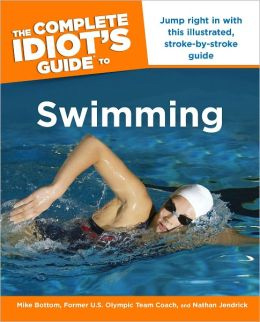 This book is a mixed bag. Since it is a “Complete Idiot’s Guide,” one might expect some information on getting started by floating, kicking, and other standard exercises leading up to a basic crawl stroke. Unfortunately, for true beginners, all that is offered is guidance in finding lessons and a proper instructor. This is good information, but disappointing. Also, 25 pages are devoted to things such as swimsuits (and how to care for them!), goggles, pool etiquette, types of pools, and on and on. A bit too much of a shopper’s guide, IMHO.
This book is a mixed bag. Since it is a “Complete Idiot’s Guide,” one might expect some information on getting started by floating, kicking, and other standard exercises leading up to a basic crawl stroke. Unfortunately, for true beginners, all that is offered is guidance in finding lessons and a proper instructor. This is good information, but disappointing. Also, 25 pages are devoted to things such as swimsuits (and how to care for them!), goggles, pool etiquette, types of pools, and on and on. A bit too much of a shopper’s guide, IMHO.
Eventually, they get around to techniques for the basic strokes (crawl, backstroke, breaststroke, and butterfly). This is somewhat advanced, and is good reading for those who want to improve their stroke. Not so good for beginners (e.g. someone who struggles to swim 200 yds. ) Additional chapters cover a wide variety of topics involving training, racing starts and turns, and dry land exercises.
Sorry-this book is mediocre, mis-titled, and not recommended.

